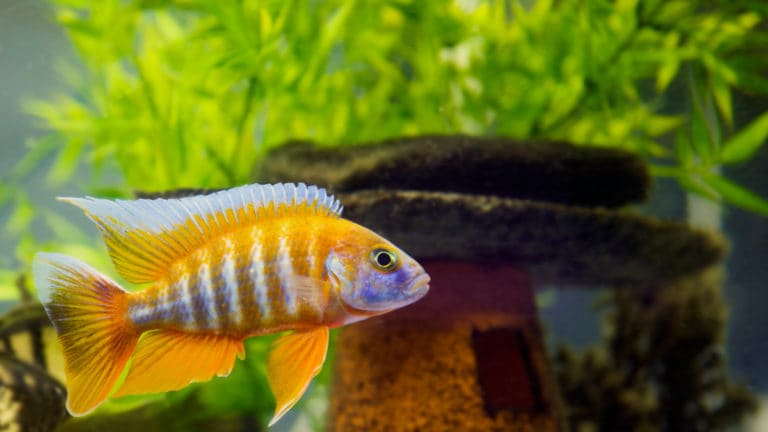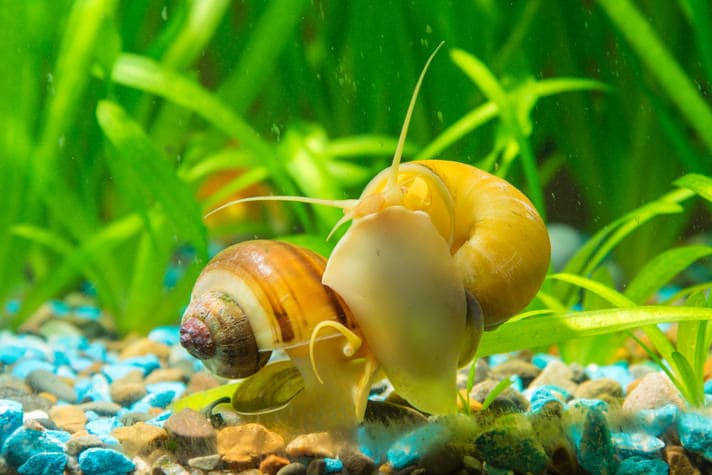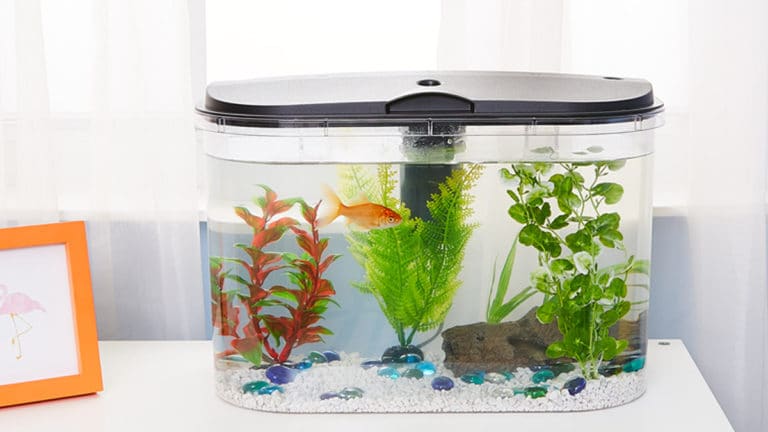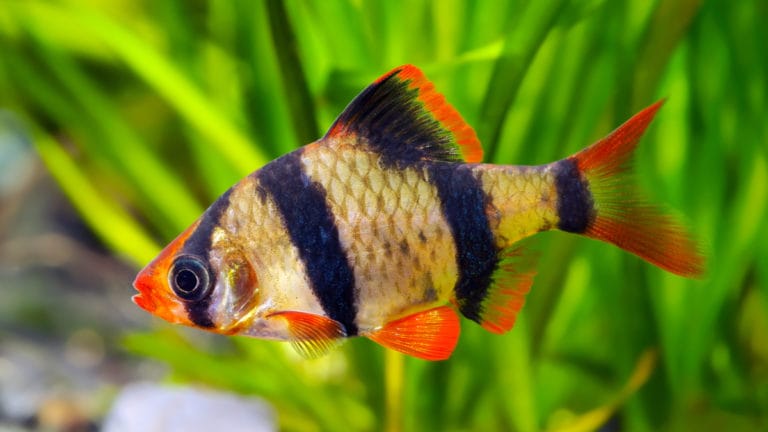The figure 8 puffer (Tetraodon biocellatus) is the perfect puffer for beginner brackish pufferkeepers. It is one of the most colorful of the puffer species, keeping its beautiful markings into adulthood. The figure 8 puffer is friendly, personable and entertaining. And it stays small enough to keep a single specimen in a 15-gallon fish aquarium.
The first rule to remember: larger is always better when it comes to aquariums for these puffers—remember, they like to swim! I recommend 10 gallons for every extra puffer you may want to add. Also, a longer tank will give them more swimming room than a tall tank. Individual specimens have proven to live longer and seem to have a better relationship with their keepers.
Most will get along with conspecifics and other smaller brackish tankmates, such as gobies and small species of mollies (I’ve seen figure 8 puffers bullied by sailfin mollies). If keeping multiple figure 8 puffers together, it would be best to start them out together as juveniles and let them grow up together. Older puffers may not tolerate the addition of new puffer tankmates.
Figure 8 Pufferfish Tank Parameters
Figure 8 puffers are warm-water tropical fish, so a temperature of around 78 degrees Fahrenheit is best for them. A substrate of crushed coral or aragonite sand is recommended to keep the pH at a steady level of around 8. Puffers have no scales or gills covers and are extremely sensitive to the toxins present in a cycling tank.
As is recommended with all fish, figure 8 puffers must be placed into a fully cycled tank, with no ammonia or nitrites and low nitrates (under 20 ppm). Although mostly found in fresh water, it has been found that Tetraodon biocellatus is best kept in a low-end brackish setup with a specific gravity (SG) of around 1.005 to 1.008. If kept in fresh water, their immune systems are compromised, causing disease and early death for fish that can live into their late teens. The longest-lived figure 8 puffer kept in brackish water was documented at more than 18 years old!
Tetraodon biocellatus specimens are found in slowly moving or standing freshwater habitats from Borneo to Thailand. They still survive best in captivity in low-end brackish water or at the very minimum, very hard fresh water, which is harder to achieve than adding marine salt to your water. Most brackish puffers are sold in fresh water at local fish shops, so it is best to use a fish-less cycling technique in your tank at whatever SG the puffers are kept at in the store you are purchasing them from (bring your own hydrometer/refractometer to check the SG).
After your new puffer is comfortable in your tank, you can raise the SG slowly (.001 to .002 per week), so you won’t disturb the biological filter bacteria in the tank you just cycled. You must use marine salt and measure it with a hydrometer or refractometer. Be sure to find a hydrometer that starts at 1.000 (fresh water).
SeaTest and Instant Ocean are two suggested brands of hydrometers that start at 1.000. If you are adding the fish from fresh water to your already established brackish tank, you can drip-acclimate the fish with an air hose knotted so it drips your tank water into a bucket with the water the fish came in, until the salt levels in the bucket match the salt levels inside your brackish tank.
I have found that for low-end brackish-water fish that the brand of salt isn’t very important. I go with the cheapest brand I can find, as long as it is made for marine tanks. Overfiltration is recommended for these fish. Most importantly, 50-percent weekly water changes are the best way to keep your figure 8 puffers healthy and happy.
Decorating Your Figure 8 Pufferfish Tank
All puffers are intelligent, curious creatures that bore easily. I have read many letters from people complaining about their puffers pacing the glass. It is preferred to have visually complex fish tank decorations in the tank for them to explore, breaking up the lines of sight, especially with multiple puffers. Plants, caves, rockwork and even plastic tubes that are similar to Habitrail’s are quite fun for figure 8 puffers to swim through. You can also try your hand at some of the available brackish plants. At the top of that list are Java fern and Java moss.
Even with the proper décor, you must also take time and observe their behavior, as all puffers are, at the minimum, potential vicious fin-nippers or possibly murderous killers. Even the most seemingly mild-mannered puffer can kill overnight. Watch for fin-nipping and missing fish. Take action immediately if you find it necessary to separate any of the culprits.
Identifying the Figure 8 Pufferfish
Puffers are consistently misidentified and mislabelled by suppliers and shops. Many figure 8 puffers do not have an eight-shaped mark on their back. The most common identifying marks on the figure 8 puffer are the black ocelli or two eyespots at each side of the puffer—one is in front of the caudal fin and one is below the dorsal.
Eyespots have developed in many animals to fool predators into thinking the wrong end is facing them. This way they won’t be approached by predators from behind. Biocellatus actually means eyespot. Figure 8 puffers only grow to around 3 inches. If you hear of one that is much larger than that size, you can assume it is actually the Ceylon puffer (T. fluviatilis), which closely resembles the figure 8 puffer in body pattern, except for spots on its belly and its much larger adult size.
Figure 8 Pufferfish Care
I like to purchase all my fish as juveniles and grow them up properly, with good, meaty, vitamin-packed fish food, to make into healthy adults. I have two figure 8 puffers right now, living in a 20-gallon tank with a few mollies (to clean up the hair-algae problem I had) and a dragon goby.
I am relieved to see they aren’t picking on the slow-moving goby. It is unfortunate that I found out too late what great jumpers they are because I lost two of them that jumped out of small openings in their tank. Now I keep every opening covered.
I strongly advise against keeping your figure 8 puffer with other species of puffers. Many folks claim to have successfully kept them with green spotted puffers (T. nigroviridis). That combination may only work for a short time, while both are juveniles. Eventually, the green spotted puffer gets meaner, three times larger and requires a much higher specific gravity as well as marine conditions as an adult. One day, everything seems fine, the next day, you may find your precious figure 8 puffers dead. So don’t do it.
What to Look For in a Figure 8 Pufferfish
You should look for a puffer that happily greets you at the front of the tank. Unfortunately, many puffers are kept in improper, overcrowded conditions and may possibly have bites and frayed fins and are in generally poor health. Try to pick the healthiest-looking puffer, and if they all look to be in poor condition, pass on them and complain to the shop owner.
Ask to see the figure 8 puffers eat and check for ich on the body and fins (ich looks like salt has been shaken on the fish). If it eats, doesn’t look emaciated, swims actively and otherwise looks generally healthy, that’s the puffer for you. Puffers can be easily treated with API Melafix for bites and frayed fins and heal quickly in a clean, cycled tank. Be sure the person catching your fish scoops it out with a container, not a net, because if the puffer puffs out of water, it can fill with air that it cannot expel on its own. This can become deadly for the puffer, unless the air is “burped” from the fish’s stomach.
You can hold it upright, with its head underwater and gently shake the puffer back and forth until the air is expelled. Puffing is a natural defense mechanism, with puffers pushing their spines outward and making themselves look like a larger meal than they really are. Do not try to scare your poor puffer into inflating.
Wild-Caught Considerations
Since there is no documentation on this species successfully breeding in captivity, you can assume these are wild-caught puffers. Many wild-caught fish come to us with internal parasites. Internal parasites should be treated internally, so it is important to be sure your puffer is used to the dead foods you are offering it (fish in the wild eat live foods), before you treat its food with medication.
If you are having difficulty with the transition to dead foods, you can try soaking the food in garlic or bouncing the food on the end of a thread in front of your puffers, making the food appear alive.
So, if you are looking for a new addition to your aquarium that is colorful, comical and compact, and you are willing to go the extra mile to keep brackish water for it, then this just might be the perfect fish for you!
Jeni Tyrell has been in the hobby for 30 years and has worked in the industry for many years. She has more than a decade’s worth of experience keeping puffers. She presently houses nine tanks, including freshwater, brackish and reef systems. She wrote pufferfish profiles for the 2005 Encyclopedia of Exotic Tropical Fishes, and her articles have been published in several aquarium magazines. She runs the pufferfish website: www.thepufferforum.com. Her online moniker is Pufferpunk.
Share:









